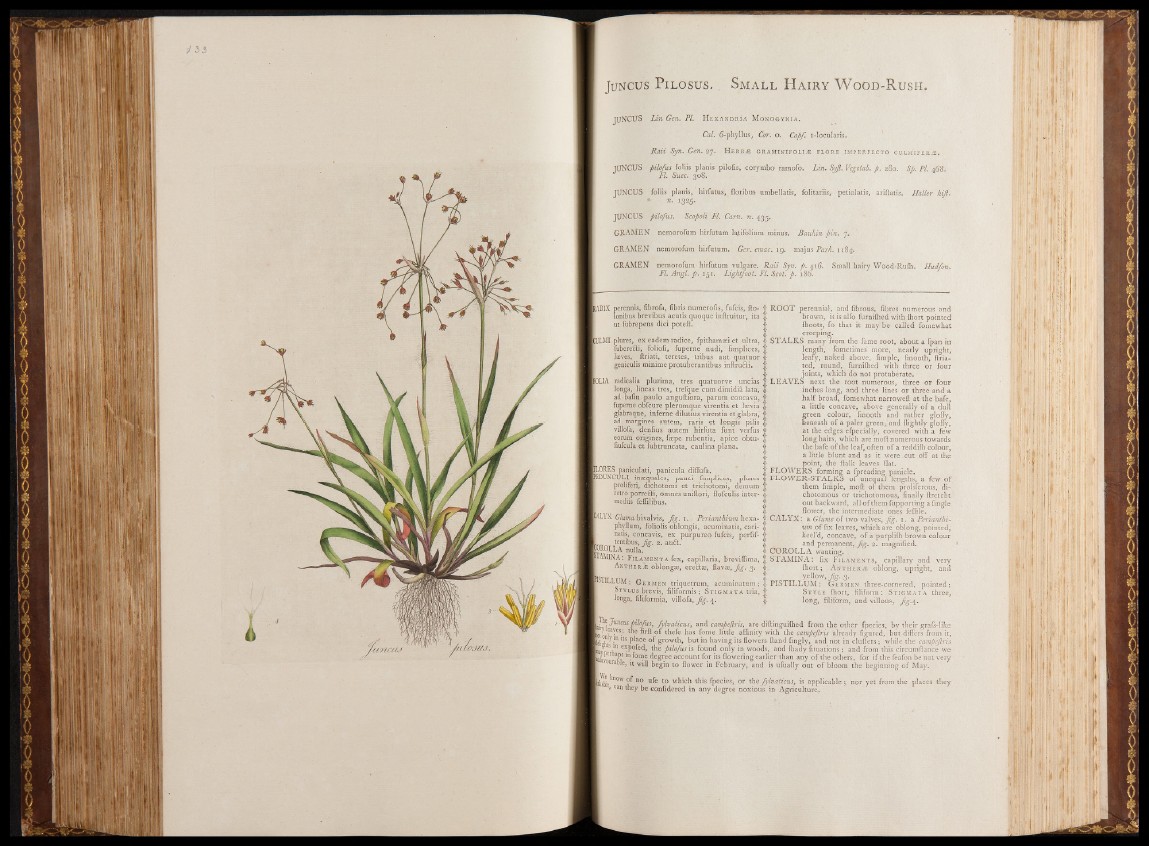
J u n c u s PiLOsus.. Small Hairy Wood-Rush
JUNCUS Lin Gen. Pi. Hexandria M o nogynia.
Cal. 6-phyllus, Cor. o. Capf. l-locularis.
Rail Syn. Gen. 27. Herb as g ram inifo lias flore imperfecto culmifer.#.
JUNCUS pilofus foliis planis pilofis, corymbö ramofo. Lin.SyJl. Vegetal, p. 280. Sp. PL 468.'
FI. Suec. 308.
JUNCUS foliis plants, hirfutus, floribus umbellati's, folitariis, petiolatis, ariftatis. Haller hiß.
V * n. 1325.
JUNCUS pilofus. Scopoli FI. Cam. n. 435..- -
GRAMEN nemorofum hirfutum latifolium minus. Bauhin pin. f .
GRAMEN nemorofum hirfutum. Ger. emac. ig. majus Park. 1184^
GRAMEN nemorofum hirfutum vulgare. Raii Syn. p. 416. Small hairy Wood-Rufh. Hudfon.
Fl. Angl. p. 151. Lightfoot. FI. Scot. p. 186.
ADIX perennis, fibrofa, fibris numerofis, fufcis, fto- $
lonibus brevibus acutis quoque inftruitur, ita a
ut fubrepens dici poteft. |
<j>
#LMI plures, ex eadem radice, fpithamæi et ultra, \
fubereÊli, foliofi, fuperne nudi, fimplices, |
læves, ftriati, teretes, tribus aut quatuor $
geniculis minime protuberantibus inftru&i. f - , , l
^OLIA radicalia plurima, très quatuorve uncias Y
longa, lineas très, trefque cum dimidiâ lata, <j>
ad balin paulo anguftiora, parum concava, y
fuperne obfeure plerumque virentia et lævia a
glabraque, infèrne dilutius virentia etglabra, Ç
ad margines autem, raris et longis pilis |
villofa, denfius autem hirfuta funt verfus 0
eorum origines, fæpe rubentia, apice obtu- |
fiufcula et fubtruncata, caulina plana. $
AORES paniculati, panicula diffufa. ° Y
^EDUNCULI inaequales, pauci fimplices, plures A
proliferi, dichotomi et trichotomi, demum Y
retro porrefti, omnes uniflori, flofculis inter-
mediis feffilibus. . f
"ALYX Gluma bivalvis, fig. 1 .. Perianthium hexa-
phyllum, foliolis oblongis, acuminatis, cari7 a
natis, concavis, ex purpureo fufcis, perfif-
tentibus, fig . 2. au6l. ' i
COROLLA nulla; •
JTAMINA: Fi l am e n t a fex, capillaria, breviffima, |
A nther i oblongas, ereftas, flavae, fig. 3. |>
jlST ILLUM : G ermen triquetrum, a cum in a tum ;!
St y lu s .brevis, filiformis; S t ig m a t a tria, ^
longa, filiformia, villofa, fig. 4. |
RO OT perennial, and fibrous, fibres numerous and
brown, it is alfo furnifhed with fhort pointed1
fhoots, fo that it may be called fomewhat
creeping.
STA LK S many from the fame root, about a fpan in
length, fometimes more, nearly upright,
leafy, naked above, fimple, fmooth, ftria-
ted, round, furnifhed with three or four
joints, which do not protuberate.
LEAVES next the root numerous, three or four
inches long, and three lines or three and a
half broad, fomewhat narroweft at the bafe,
a little concave, above generally o f a dull
green colour, fmooth and rather gloffy,
beneath of a paler green, and {lightly gloffy,
at the edges efpecially, covered with a few
long hairs, which are moft numerous towards
the bafe of the leaf, often of a reddifh colour,
a little blunt and as it were.cut off at the
point, the ftalk leaves flat.
FLOWERS forming a fpreading panicle.
F LOWER-STALKS of unequal lengths, a few of
them fimple, moft of them proliferous, dichotomous
or trichotomous, finally ftretcht
out backward, all of them fupporting a fingle
flower, the intermediate ones feffile.
CA L YX : a Glume of two valves, fig. 1. a Perianthium
of fix leaves, which are oblong, pointed,
keel’d, concave, o f a purplifh brown colour
and permanent, fig. 2. magnified.
CO ROL LA wanting.
STAMINA: fix Filaments, capillary and very
fhort; A nther as oblong, upright, and
yellow, fig. 3,
PISTILLUM : G ermen three-cornered, pointed;
St y le fhort, filiform: .St igm a ta three,
long, filiform, and villous, Jig.\.
he Juncus tiilofus, fylvaticus, and campejlris, are diftinguifhed from the other fpecies, by their grafs-like
Wt of thefe has fome little affinity with the campejlris already figured, but differs from it,
S i l l lts P'ace of growth, but in having its flowers Hand fingly, and not in clufters ; while the campejlris
i j V n e?Pofed, the pilofus is found only in woods, and fhady fituations ; and from this circumftance we
kavo^-af f . on}e degree account for its flowering earlier than any of the others, for if the feafon be not very
[ Ula ■le> 11 will begin to flower in February, and is ufually Out of bloom the beginning of May.
Ë j f l f l vf n° U^e t0 fpecies, or the fylyaticus, is applicable; nor yet from the places they
> can they be confidered in any degree noxious in Agriculture.